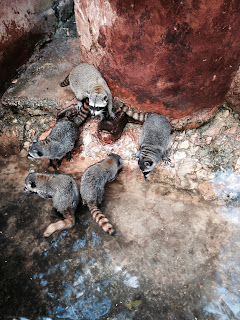 |
| Merida; the White City |
Our accommodation is a sweet, hidden little treasure in the back alleys of Merida. A mix of Spanish and French, all black grills and doors that open 12 different ways, the Duck and I find ourselves cosy and comfortable in this quiet bed and breakfast chalet run by a diffident French woman. It's just what we need after an uncomfortable 8 hour overnight bus ride.
 |
| Our accommodation in Merida |
We have now left the rainforest states of Chiapis and Campeche and have made it to the coastal state of Yucatan (at the top of the much larger Yucatan peninsula, the bit of Mexico that juts out into the Atlantic and Caribbean). Merida is the state's capital.
Being a sunny, provincial, colonial sort of town, the Duck puts on a dress before we head out into Merida for the day and pops her hands into her pockets. She absentmindedly pulls out a handful of black pebbles.
"What's that?" I ask.
She looks confused for a moment and then a realisation dawns on her, "It's volcanic rock!"
"Where from...?"
We both put
two and two together. It's from Sunset Crater in Arizona. Duck was wearing this dress when she tripped, her pockets having accidentally filled up with bits of the crater. A week or two later, she still wears the strap on her foot that we picked up in a drugstore.
The Duck looks sad, "But it said in the park 'do not take the rocks'..."
I laugh and the Duck puts them aside, unsure what to do with them.
 |
| Merida boasts some very pretty architecture |
Merida is known in Mexico as 'the White City'. Many of the buildings are blocky and European, shades of sandy grey and white and a few crumbling pastels. It's busy and metropolitan but lacks the dangerous edge of Mexico City. It's colonial but it doesn't really sell itself as a historical place of heritage in the way that Oaxaca or San Cristobal de las Casas do. There's a bit of a metro-hipster element - little stencils of birds are to be found all over the laneways, there's a few indie craft shops, and I even see a guy in a Descendants shirt. As we walk towards one of the big churches a guy standing on the corner hears us talking in English and jumps into action, keen to practise his own English on us (we've met a few Mexicans like this now so it doesn't seem strange to us). He helps us work out a few places to visit and animatedly recommends a restaurant.
We scope out the 'Mayan' markets found on the 2nd floor of a building after two more locals direct us there. The salesman inside looks more Mexican than Maya, and there is a surprising amount of penis-related sculptures dotted around the building. I don't believe this an authentic Maya market.
After this I lead the Duck to the Museo de Popular Arte, which turns out to be small but free. The curator tells us very sternly and slowly about each of the rooms before letting us in. The art is from all over Mexico, mostly sculptures. The best is a room that contains 32 separate models of the Nativity Scene from all different parts of Mexico; some carved in wood, some woven into rugs, some Asian in style, others indigenous. The unifying theme of Christianity is fitting for a Mexican art museum but the scope of interpretation represents the full complexity of Mexican cultural identity.
I have to be honest, today I felt homesick. One of the sculptures (a pumpkin) randomly reminds me of something from home and I begin to think of all the things I'll be glad to see and do when I get back to Australia. Even at the age of 34 I've never been overseas before, let alone to a non-English speaking country. It's been an amazing experience but the culture shock isn't something that I was prepared for.
 |
| Mexican art and aesthetics seem to predominantly (and paradoxically) reflect a preoccupation with death and the radiance of nature in all its colourful hues. |
My ambivalence towards Merida is compounded by a trip to the city's zoological park. This is a large park divided into an empty fairground and a free zoo. I'm not sure what the deal is, but the fairground looks like it used to be part of the zoo and is now just these fading, kitschy statues. There a bunch of fairground rides that no one is interested in. Two of the statues are highly racist African-American caricatures. I feel like it's been a long time since this zoo ran at full steam. The actual zoo makes me sad.

































No comments:
Post a Comment